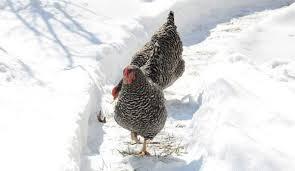As winter approaches, it is important to make sure that equipment and housing are ready well in advance. By starting winter preparations early, there will be plenty of time to fix any problems before the cold sets in. In order to help the birds continue to be productive during the winter months, we suggest the following:
Protect them from the weather
- Shelter – Check poultry housing before winter sets in and fix any leaking roofs that will allow moisture into the coop. Remember, moisture in the coop can lead to increased levels of ammonia, as well as make it more difficult for the birds to stay warm. Look for and fix any cracks or holes that will allow wind to blow into the building. Holes that allow fresh air to blow directly on the birds can chill them and lead to problems. Holes can be filled with spray foam insulation, or by hanging a thick plastic sheet or tarp over problem areas.
- Situate the housing so that sunlight can enter during the day and heat the house.
- Perches – Avoid materials like metal and plastic pipes when constructing perches as they will conduct the cold to the feet of the birds and can result in frost bite. Instead, use wood as it will not conduct cold. Preferably, perches should have a flat surface (like a 2x4) that will allow the birds to cover their feet with their feathers when on the perch to keep them warm.
- Insulation – While insulation is not necessary, it will help keep the heat generated by the birds in the coop and keep the coldest weather out. If you are adding heat to a house, then insulation is a cheap way to get the most heating for your money. Insulation is also beneficial during the summer to keep heat out.
- Heat – Young birds will need a source of heat in order to survive and grow. As long as adult birds are protected from the wind and wet weather, they should not need any additional heat even during the coldest time of year. While not necessary, adding heat to older birds will help them maintain egg production throughout the winter.
Ventilation
- Fresh air is important in order to provide O2 for the birds as well as to remove CO2 and moisture. Make sure that fresh air entering the building mixes with the internal (warmer) air before it gets to the birds.
Water
- While water consumption typically declines in the winter, birds still need water to survive.
- Water that is frozen over is not available to the birds and they can’t break through the ice to get to the water.
- Check the water several times a day and make sure that it is not frozen and is available to the birds.
- Another alternative is to keep the water warm. This can be done by using a heater that goes under the waterer. This will then heat the water and keep it from freezing. This will require an electrical source. Another way to keep water warm is to use a heat lamp so that it keeps the water warm. Be careful not to splash cold water on a hot heat lamp as the bulb may shatter.
Feed
- Feed them in the evening to keep them warm all night.
Use deep litter to keep them warm
- In addition to providing insulation from the ground, deep litter also generates heat as it is broken down by microbial action.
Petroleum jelly on combs and wattles protects from frostbite
Remember, the wellbeing of your birds is your responsibility. Make sure to provide them with a safe place that is out of the weather and have food and water (not frozen) so that they can make it through this difficult time of year.
